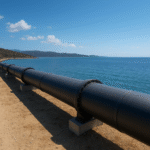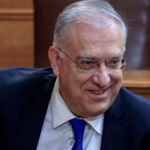In less than a month, Guilfoyle has reshaped the diplomatic agenda in Athens—touching energy, defense, shipping, culture, and great-power politics.
By Christos Mytilinios
When Kimberly Guilfoyle touched down in Athens on November 1st to begin her tenure as the new United States Ambassador to Greece, few could have predicted the pace she would set. In under three weeks, Guilfoyle has managed to complete the entire diplomatic protocol cycle, launch major public initiatives, send strong geopolitical signals, ignite a U.S.–China confrontation over the Port of Piraeus, and establish herself as one of the most visible American envoys in recent memory.
Her mission, as it’s already becoming clear, is not ceremonial. It’s strategic, intensely political, and deeply connected to the broader realignment of the Eastern Mediterranean in energy, infrastructure, and security.
A Hyper-Active Start: From Protocol to Politics
Guilfoyle’s official term began on November 4th, when she presented her credentials to the President of the Hellenic Republic, Konstantinos Tasoulas. Within hours she had moved to the Ministry of Foreign Affairs for her first high-level briefing with Foreign Minister Giorgos Gerapetritis. The agenda was anything but superficial: the U.S.–Greece defense architecture, regional security, the Souda Bay base, and America’s strategic interest in Greece as an energy transit hub for Europe.
The following day she met Prime Minister Kyriakos Mitsotakis at the Maximos Mansion. Their interaction—both formal and decidedly friendly—set the tone for the new era: Greece as a “pillar of stability”, the U.S. as its committed strategic partner, and energy security at the heart of bilateral planning. Guilfoyle, in her trademark communicative style, described the meeting as “fantastic,” stepping outside the building to greet schoolchildren who happened to be visiting.
This was diplomacy with flair—substantive, but also heavily image-driven.
Turning to Soft Power: Church, Media, Public Messaging
Guilfoyle moved quickly to establish soft-power links as well. Her visit to Archbishop Ieronymos was widely interpreted as an effort to cultivate a bridge with the influential Orthodox Church, a powerful institution in Greek society and politics.
Almost simultaneously, she launched her public communication strategy:
• a viral welcome video (“Hello Greece”) positioning Greece as a vital ally,
• targeted TV interviews that blended policy messaging with personal storytelling,
• warm references to her previous visits to Greece and her honeymoon in the country.
Within days, she had become a familiar face to the Greek public—a rare occurrence for newly arrived ambassadors.
Energy First: Making Greece a Hub of American Strategy
If one area defines Guilfoyle’s early agenda, it is energy.
At the 1st Energy & Sustainability Knowledge Forum, she delivered a forceful message: the United States sees Greece as a frontline player in Europe’s diversification away from Russian gas. She highlighted:
• the long-term U.S. LNG supply agreements through Greek gateways,
• the strategic value of the Vertical Corridor linking Greece to the Balkans and Central Europe,
• the role of American companies such as ExxonMobil in upcoming Greek offshore exploration.
Greece, in her framing, is not merely a regional ally—it is a geostrategic energy bridge.
Shipping and the Port of Piraeus: Triggering a U.S.–China Flashpoint
Her most politically explosive intervention came in mid-November. In a televised interview, Guilfoyle publicly criticized China’s state-owned COSCO for its controlling stake in the Port of Piraeus, calling the investment “unfortunate” and suggesting that Greece would be “better served” by partners aligned with the United States.
The reaction from Beijing was immediate and unusually sharp.
The Chinese Embassy condemned the remarks as a “serious interference” in Greek affairs.
Beijing insisted that Piraeus “is not for sale,” as markets reacted and the OLP stock dipped.
With a single statement, Guilfoyle pushed the U.S.–Greece–China triangle into the spotlight—highlighting Washington’s renewed interest in the maritime and logistics footprint of the Eastern Mediterranean.
And she did not stop there.
Her elevation to Honorary President of the Propeller Club of Piraeus—a long-standing institution linking U.S. shipping interests with Greek maritime elites—gave further weight to her intentions. In a carefully crafted speech, she invoked the historical bond shaped by the 98 Liberty Ships the U.S. provided to Greece after World War II.
The symbolism was unmistakable: maritime cooperation is back at the center of U.S.–Greece relations.
Investments, Industry, and the Elefsina Puzzle
Guilfoyle has also focused on American investment projects, particularly:
• the revitalization of the Elefsina Shipyards,
• the involvement of ONEX Shipyards and the U.S. Development Finance Corporation (DFC),
• the ambition to transform Elefsina into an energy and logistics hub.
Her meeting with the Minister of Development underscored Washington’s commitment to keeping key industrial assets aligned with Western—rather than rival—interests.
Economy and Institutions: Aligning with Greece’s Reform Agenda
Her visit to the Ministry of National Economy and Finance and her meeting with Minister Kyriakos Pierrakakis added another layer: investment climate, credit upgrades, and Greece’s post-pandemic growth path.
The timing was notable. Guilfoyle met Pierrakakis on the very days when Greek and European media speculated about his potential candidacy for the Eurogroup presidency. While no positions were publicly confirmed, the optics of the meeting were politically meaningful.
She also engaged with American-Hellenic Chamber of Commerce (AmCham) leaders, delivering a clear message: U.S. companies are expected to deepen their engagement in Greece’s energy, tech, and infrastructure sectors.
Cultural Diplomacy: Protecting Antiquities & Expanding Agreements
Guilfoyle concluded her third week with a meeting with Minister Lina Mendoni on cultural heritage protection and the renewal of the bilateral Memorandum of Understanding on antiquities (due in 2026). This is a priority for both governments, given Greece’s decades-long effort to combat illegal trafficking.
It was a reminder that her agenda is not solely geopolitical—it spans culture, legal cooperation, and the preservation of shared heritage.
The Larger Picture: What Guilfoyle Represents
Her whirlwind first weeks signal three strategic priorities:
1. A More Assertive U.S. Presence in Greece
Washington wants to secure critical infrastructures—energy, shipping, ports—as geopolitical competition with China intensifies.
2. Strengthening Greece as a Regional Anchor
From LNG terminals to defense cooperation, Guilfoyle positions Greece as a stabilizing node in the Balkans, the Middle East, and the Eastern Mediterranean.
3. Personal Diplomacy With High Visibility
Her style—high-energy, media-savvy, politically sharp—is reshaping expectations for what an American ambassador looks like in the 2020s.
This is not classic diplomacy. This is diplomacy with political velocity.
A New Era in Athens–Washington Dynamics
In less than a month, Kimberly Guilfoyle has shown that she intends to be one of the most influential American ambassadors Greece has ever hosted. She has already touched every major pillar of bilateral relations—defense, energy, investment, shipping, culture, and regional security—while simultaneously crafting a strong public persona.
If her first 20 days are any indication, the next years of U.S.–Greece relations will be fast-moving, strategically charged, and anything but quiet.





